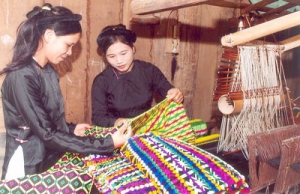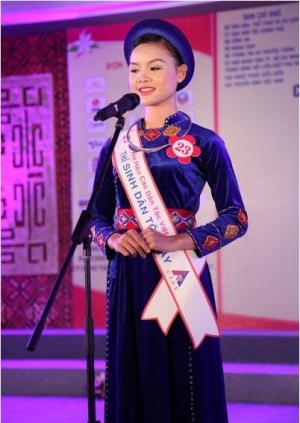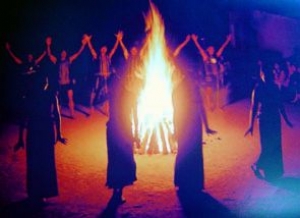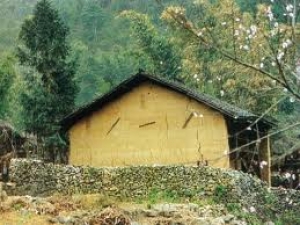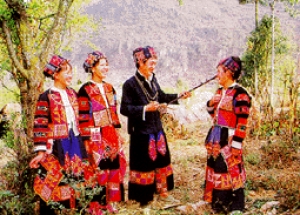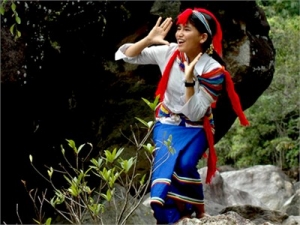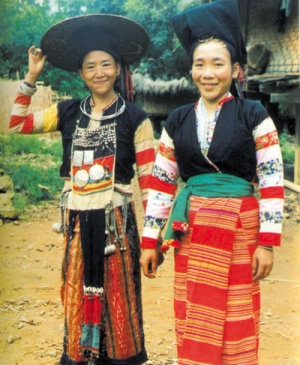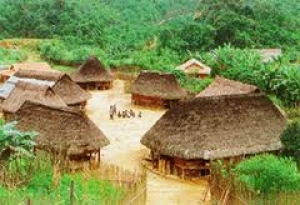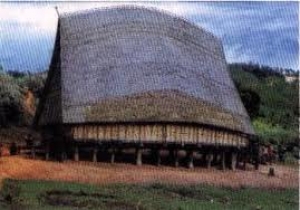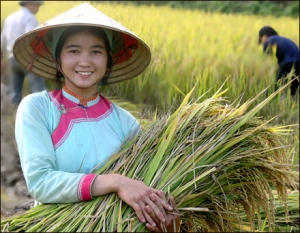
Asia Pacific Travel Team
The Tay ethnic group with folk cultural beauty
Proper name: Tho
Population: 1,190,342 people
Local groups: Tho, Ngan, Phen, Thu Lao, and PaDi.
Language: Tay language belongs to the Tay-Thai language group (Tai-Kadai language family)
History: The Tay have been present in Vietnam for millennia, perhaps as early as 500BC.
Production activities: The Tay are farmers who have a long tradition or wet rice cultivation. They have a long history of intensive cultivation and irrigation methods like digging canals, laying water pipes, etc. They also maintain the custom of harvesting the rice and thrashing the grains out on wooden racks, which they call loong, while still in the fields, then carrying the threshed rice home in baskets. In addition to cultivating wet fields,the Tay also plant rice on terraced fields along with the other crops and fruit trees. Cattle and poultry raising are well-developed, but a free range style of animal husbandry is still popular. Household crafts are worthy of note. The most famous Tay craft is weaving brocaded designs of beautiful and original patterns which are highly prized. The local market is also an important economic activity.
Diet: In the past, in several places, the Tay ate mainly sticky rice, and almost every family used stew and steam pots for cooking. On festival occasions, they make many kinds of cakes, such as square rice cakes (banh chung), round rice cake (banh day), black rice sesame cake (banh gai), lime-water dumpling, fried rice cake, marble dumplings made of rice white rice flour with rock sugar fillings, patty make of mashed rice, etc. There are special cakes made from flour with an ant egg filling, and com, a young rice confection made from smoked sticky rice, roasted, and pounced.
Clothing: Tay traditional dress is made from homegrown cotton that is indigo dyed. There is usually not much embroidery or other decorations. Women wear skirts or trousers, with short shirts inside and long one worn on the outside. The Ngan group wears shorter shirts, the Phen group wears brown shirts, the Thu Lao group wears conical-shaped scarves on their heads, the Pa Di group wears hats that look like house roofs, and the Tho group tend to dress like the Thai in Mai Chau (Hoa Binh province).
Lifestyle: The Tay have settled in valleys in the Northeastern part of the country: Quang Ninh, Bac Giang, Lang Son, Cao Bang, Bac Can, Thai Nguyen, Ha Giang, Tuyen Quang, Lao Cai, Yen Bai. Their villages are characteristically large and crowded, and there are villages with hundreds of houses.
The Tay traditional house is built on stilts with a frame of rafters and 4, 5, 6, or 7 rows of columns. A house has from 2 to 4 roofs made from tiles, straw, or palm leaves. Wood or bamboo is used to make the walls.
Transportation: The Tay use shoulder poles and baskets to carry small, tidy bundles, or carry them over the shoulder in cloth bags. Larger bulkier items are carried by buffalo or with the help of other people. Rafts and floats may also be used to transport items by water.
Social organization: The Tay’s Quang regime is a form of social organization which resembles a feudal system that is aristocratic and hereditary. Within its rule region, the Quang owns all lands, forests, rivers, etc. Hence, it has the right to control everyone who lives on that land and to exploit these people through forced labor, imposing duties on commodities, and enforcing the payment of tributes and offerings. The Quang regime appeared very early and persisted until the end of the 19th century or the beginning of the 20th century.
Marriage: Young Tay men and women are free to love and to date each other. However, the decision to become husband and wife depends on their parents and whether their fates match each other’s suitably. That’s why in the marriage proceedings, the groom’s family asks for the bride’s fortune to be read and then brings it home to compare it to the fortune of their son. After the wedding, the wife stays with her parents until she is pregnant. It is only before giving birth that the wife goes to her husband’s family to live.
Birth: While pregnant, and after giving birth, the mother and even the father have to avoid many different things in order for both mother and child to be healthy, for the child to grow up quickly, strongly, and to avoid evil spirits.
Three days after an infant is born, purification is performed while establishing the altar to honor the midwife. One month after the birth, there is a celebration and naming party for the infant.
Funerals: Tay funerals are lavishly and elaborately organized with many rituals in order to fulfill filial duty and to bring the spirit of the deceased to the world of the afterlife. Three years after burial, there is a ritual to end the mourning period and to bring the spirit to the ancestral altar. There is an annual day for worshiping.
New House: When building a new house, the owner has to choose a new house, the owner has to choose the land and the direction for the house, examine the age of the man who will head up the construction of the house, and select a good day for building. On the day they move to a new house, the head of a family must start a fire and keep it burning all night.
Beliefs: The Tay mainly worship ancestors. They also worship the House God, Kitchen God, and the Midwife.
Festivals: there are many Festivals and holidays which bear different meanings in a year. The Lunar New Year that starts a new year and the mid0July Festivals are the most lavishly organized. A spirit-calling festival for cows and water buffaloes happens on the 6th of June (according to the lunar calendar). Ceremonies held after seeding and for the new rice festival held before harvest are characteristic among farmers who practice wet rice cultivation.
Calendar: The Tay follow the lunar calendar.
Education: The Tay’s alphabet is pictographic, similar to the Viet’s alphabet at the beginning of the 20th century. It is used to write poems, stories, songs, prayers, etc. The Tay-Nung alphabet builds on the Latin alphabet and was invented in 1960. it remained in use until the mid 1980s and was used in elementary schools where there Tay and Nung people lived.
Artistic activities: The Tay have many folk song melodies such as luon, phong slu, phuoi pac, puoi ruoi, ven eng…Luon includes different tunes of luon coi, luon sluong, luon the, luon nang oi, which are alternating verses popular in many regions. The Tay sing luon at long tong Festivals, weddings, new house parties, or when there are guests in the village. Besides, festival dancing, in some local groups, there are also puppet performances using unique wooden puppets.
Entertainment: On the occasions of long tong festival, people in many places play con throwing, badminton, tug-of-war, dragon dancing, chess, etc. Children play spinning top and other games such as khang and chat or o an quan.
Come to San Chay ethnic group and sing with them
Proper name: San Chay
Other names: Hon Ban, Chung, Trai.
Population: 114,012 people
Local groups: Cao Lan and San Chi
Language: The language of the Cao Lan belongs to the Tay-Nung group (of the Tai-Kadai language family) and the language of the San Chi belongs to the
Handicrafts groups (of the Sino-Tibetan language family).
History: The Sanchay migrated from China to Vietnam about 400 years ago.
Production activities: The Sanchay are an agricultural people who farm mainly wet rice paddies, but they also cultivate swidden fields which they prepare by the slash-and-burn method. They use the digging stick to make holes for seedlings. Fish catching plays an important role in their economic life as well. With their unique fishing tools, such as hand nets and woven baskets, fish catching supplies the Sanchay food and improves their daily meals.
Diet: The Sanchay eat mainly ordinary rice. They also drink a lot of wine especially during the Tet holidays or Festivals. Men smoke tobacco in a water pipe. Women chew betel.
Clothing: Sanchay women wear the Cham-style skirt and long shirt or tunic which is decorated around the bottom hem and on the back. For daily wear, Sanchay women wear one Cham0style cloth belt, but on special occasions, like the Tet New Year festival, they wear two or three silk belts of different colors.
Housing: The Sanchay live in the provinces of the northeast. They live in the stilt houses of a style similar to those of the Tay, who live in the same area.
Transportation: The Sanchay usually carry goods on a bag on their back like a back pack.
Social organization: Before the August Revolution, land and fields were private property and social classes were more distinct. Landowners and rich peasants were part of Sanchay society. Depending on the area, the colonial government had some positions such as quan man, tai cha, quan lanh…In addition, there was an autonomous system of governance in the village, one that was voted by villagers and called khan thu. There are a variety of Sanchay lineages, with some of the largest family lineages being the Hoang, Tran, La, Ninh. Both the branches of the family lineages and worshiping cults play important roles in Sanchay community life.
Marriage: Before receiving the bride, the offerings and the Clothing of the reception group must be brought together and placed in the middle of the house in order to be blessed by the son of the ritual specialists. On the way to the groom’s house, the bride must walk without wearing shoes. After the marriage, the bride will stay in husband’s house. The matchmaker is respected by the bride and groom and is considered as the couple’s parents, and when the matchmaker dies the couple must take part in her funeral rituals.
Birth: Within 42 days after giving birth, strangers are forbidden to enter the house. During this time, if someone enters the house by accident and then a child gets sick, the stranger must bring offerings to worship the gods. Three day after giving birth, the Sanchay hold the ba mai ceremony (matchmaker ritual).
Funerals: Funerals will be led by Thay Tao (ritual specialist) and consist of many rituals which are affected deeply by Taoism and Buddhism. The Sanchay burial vault is built meticulously.
New House: The Sanchay pay much attention to choosing the land, the direction of the house, and the date and time to build a new house.
Beliefs: There are many altars in the typical Sanchay house. In addition to worshiping ancestors, they also worship heaven and earth, Tho Cong (Earth Spirit), Ba Mu (Goddess), Than Nong (Agricultural Spirit) and the cattle breeding spirit. The most popular cults worship Ngoc Hoang (Goa in Heaven), Nam Hoa Buddha), Tao Quan (Kitchen Spirit).
Tet holidays and Festivals: The Sanchay also have Tet holidays, similar to the Tay people.
Calendar: The Sanchay use the Han character in worshiping and in writing songs.
Artistic activities: In addition to telling old tales and reading poems, the Sanchay also like singing. The most popular Sanchay songs are the sing calendar, alternating love songs of young people. There are two kinds of sing calendar: those sung in the village at night and those sung on the way to or at the market. The Sanchay also sing for weddings and sing lullabies.
Entertainment: Badminton and top spinning are popular Sanchay games. At ceremonies and Festivals they play a game of standing on the head, called van rau cai.
The Coho ethnic group with unique traditional cultural values
Proper name: Coho
Local groups: Xre, Nop (or Tu Nop), Co Don, Chil, Lat (or Lach) and To Ring (or Thai’ring).
Population: 92,190 people
Language: Coho language belongs to Mon-Khmer group (which is part of the Austroasiatic language family).
History: The Coho are permanent inhabitants in the Tay Nguyen region.
Production activities: With the exception of the Xre, who practice wet rice cultivation (the name Xre means sub-merged fields), other Coho sub groups cultivate rice on swidden fields which they change periodically, using the slash-and-burn method to prepare the land for planting. In general, the Coho’s farming methods and tools are similar to other groups in the Tay Nguyen region. Apart from the using of digging sticks to make holes in the scorched earth to insert seeds, the Chil people also use a tool called the p’hal, which has a long wooden handle, a blade of about 28cm in length and 3-4 cm in width, and is used both for making the holes and putting the seeds into the earth. Among the Xre, the typical farming tools are the wooden-made ngal (plough), which has a flat base and wooden blade (later made of iron) and the rake with wooden tines. Ploughs, rakes and kor (to even out the field’s surface) are drawn by oxen or buffalo. Paddy rice is the main crop, but the Coho also grow corn, manioc, gourd, pumpkin, loofah, and beans, etc. The Coho practice informal animal husbandry. They raise livestock to draw the ploughs in their fields and as animal offerings in certain ceremonial scarifies. Basketry and blacksmithing are practiced in every family, but textile weaving only prevails among the Chil sub-group. Hunting, fishing, and gathering remain popular ways to supplement the family diet.
is used both for making the holes and putting the seeds into the earth. Among the Xre, the typical farming tools are the wooden-made ngal (plough), which has a flat base and wooden blade (later made of iron) and the rake with wooden tines. Ploughs, rakes and kor (to even out the field’s surface) are drawn by oxen or buffalo. Paddy rice is the main crop, but the Coho also grow corn, manioc, gourd, pumpkin, loofah, and beans, etc. The Coho practice informal animal husbandry. They raise livestock to draw the ploughs in their fields and as animal offerings in certain ceremonial scarifies. Basketry and blacksmithing are practiced in every family, but textile weaving only prevails among the Chil sub-group. Hunting, fishing, and gathering remain popular ways to supplement the family diet.
Diet: The Coho usually eat three meals a day. Formerly, they prepare rice and soup in a length of bamboo. Later, they use earthen cooking pots, and then bronze and cast-iron ones. Food is often served dry because the Coho have a tradition of eating with their hands. Soups are cooked with vegetables, with chili and salt being added as main seasonings. Meat and fish are cooked in a fish sauce with water or boiled with the trunk of a young banana tree. The Coho store water in dried gourds or ghe. Can (pipe) wine, or tornom, which is made from rice, corn and manioc and fermented from special forest tree leaves, is popular drinks that the Coho consume at parties and Festivals. Many people still enjoy smoking locally-grown tobacco.
Clothing: Coho men wear lion cloths and women wear short skirts. The Coho loin cloth is square piece of fabric, 1.5cm to 2cm in width, with designs on the two vertical hems. A cloth wrapper or sarong is neatly wound around the body, with one corner being tucked into the waistband. The cloth wrapper is often dyed black, with white designs being arranged along the two sides. During cold weather, people tend to wrap themselves with blankets (ui). The most popular ornaments are necklaces, wrist chains, bead strings and earrings.
Housing: The Coho live mainly in Lam Dong. They live in sprawling houses on stilts with curved, thatched roofs, bamboo-woven walls for resisting the cold, and astaircase in the front. There is often an altar facing the entrance, together with a line of pots, baskets and wide-bellied jars is found on the side of the wall opposite the entrance. All family activities take place around the heart.
Social organization: The Coho village (or bon) reveals many traces of the earlier matriarchal social structure. A Coho village is headed by a chief (kuang bon). In popular area, a volunteer alliance among neighboring villages is established, led by a M’drong, or head man. The Coho have two kinds of families: extended and nuclear families. Extended family, however, is disappearing and giving way to smaller families, particularly along national highways and near the districts or townships. Matriarchy is popular. The women take the initiative in marriage. After the wedding, the husband comes to stay with his wife’s family and the children are named after their mother’s family name. Coho couples marry at a young age (girls at 16-17 years old, and boys at 18-20 years old). This accounts for a high reproductive rate among the Coho, and it is not uncommon for a Coho woman to give birth at least five times in her life.
Beliefs: The Coho believe that every aspect of life is decided by supernatural forces. They believe that while people are blessed by their own God (Yang), there are also devils and ghosts (Cha) causing disasters and mishaps. Therefore, the Coho pray for success in everything they do, seeking help for good crops, marriages, funerals, or sicknesses. People believe that the spirits like eating meat and drinking wine, and it is a function of the importance of the ceremony that one sacrifices a buffalo, pig, goat, or chicken, together with alcohol.
According to Coho tradition, rituals are regularly held relating to agriculture, such as the sowing of seeds, the appearance of new ears of rice, and rice storage. The altar nao is placed in the most respected and solemn corner of the house. There is often no longer a sophisticated wooden altar. Some simple altars take the form of tree branches on the ceiling, opposite the entrance door.
Education: A written form of the Coho language was invented in early 20th century; it is primarily based on the Latin system. Although it has been revised over the years and was taught in some of the local schools, Coho script is not widespread nowadays.
Artistic activities: Coho folktale is abundantly rich. The verses of lyrical poems of lyrical poems evoke romantic sentiments. The Coho also have many traditional dances, which are performed at Festivals and ceremonies. Their traditional musical instruments include the set of six-pattern gongs, gourd oboes (kombuat), bamboo-flutes, deer-skin drums, etc, which are used for ensemble or solo performance.
Festivals: Each year in December after the harvest, the Coho celebrate their Tet or New Year holidays. Coho families take turns sacrificing a buffalo for the village buffalo sacrifice ceremony. The ceremony is held outdoors, either in front of the house of the host who has offered the buffalo, or in front of the village chief’s house, or in the a spacious, public area in the village. People sing and dance around a ceremonial pole, called cay nieu. The meat of the sacrificed buffalo is divided and allocated to every family in the village, and its blood is applied to the foreheads or the villagers as blessings. The Tet occasion usually takes 7-10 days. The villagers circulate among the different village families to convey their greetings of the New Year. It is only after Tet, when one has eaten the new rice that one begins to implement important affairs such as building houses, moving the village to a new location, etc
The Colao ethnic group culture and customs
Proper name: Colao
Other names: Tu Du, House Ki and Voa De.
Population: 1,473 people
Local groups: Colao Sanh (or green Colao), Colao Trang (white Colao), and Colao Do (red Colao)
Language: Colao language belongs to the Kadai group, which also includes La Ha, La chi and Pupeo languages (part of the Tai-Kadai language family). In the past, local Colao sub-groups spoke different dialects. Nowadays, however, they no longer use their own mother tongues. Instead, they speak Cantonese, Pupeo and Hmong languages.
History: The Colao came to Vietnam about 150-200 years ago.
Production activities: The Colao people who live in high, rocky, mountainous areas practice slash-and-burn agriculture, cultivating swidden fields and growing maize in mountain rocky hollows. Corn is the main crop. They also grow beans, wheat, peas, kohlrabi, etc. the Colao use cattle manure, ashes and fertilizers for enhancing the soil. Ash is put into the rocky hollows after corn seeds are inserted. Some Colao who live in lowland areas cultivate terraced rice fields. Rice is the main crop and food.Traditional handicrafts include basketry (flat bamboo baskets, winnowing baskets and lattices) and woodwork (desks, cases, horse saddles, coffins and containers). Many villages have blacksmiths who produce their farm tools.
Diet: The Colao eat ground corn, called men men, or rice and use wooden bowls and spoons.
Clothing: Colao women adopted Nung and Giay styles, but they usually wear longer dresses falling below the knees. Their blouses are decorated with bands of multi-colored cloth outside hem, on the front, and on the sleeves. Formerly, the White Colao and Green Colao wore an extra short-sleeved shirt outside to show the colorful patches on the inside blouses ‘sleeves.
Housing: Colao villages are generally comprised of between 15 and 20 families. The house is divided into three compartments and two lentos, with thatched roofs or roofs made of split bamboo. The red Colao also make earthen houses, as do their neighbors, the Pupeo.
Transportation: The horse is a popular means of transportation among the Colao. They also use gui (back-baskets) with two shoulder straps to transport goods and produce. The Colao usually have to carry water to their homes. In low mountainous areas, people also make ducts or a system of gutters to bring water to their own homes.
Social organization: Each Colao sub-group has its own definite family lineages, such as Van, House, Senh and Chao (among White Colao), Min, Cao, and Su Li (Red Colao) and Sang (Green Colao). If a family does not have a son, it is likely they will let their daughter marry a local boy and allow him to stay with them. The son-in-law is entitled to inherit the property of his wife’s family. He must set up an altar for both his wife’s parents and his own ancestors.
Marriage: Marriages are different among the Colao sub-groups. According to Green Colao traditions, the bridegroom wears a long green vest and a red band of cloth draped over the shoulder. The bride must wear her hair with s chignon or bun on the top of their head. When she reaches the husband’s home, she stops at the gate and steps on a bowl and spoon which were intentionally placed on the ground. She stays at her husband’s house the first night. Wife seizing customs also occur in some Colao areas, similar to custom practiced by the H’mong.
Birth: The Colao custom is to burn the placenta and put the ash in the rocky hollows. A baby boy is usually named after three days and three nights, while girls are usually named after waiting two nights and three days. In some places, grandmother gives babies their names and presents them with gifts when the babies are one month old. This is particularly the case when a child receives a name connoting respect for the ancestors or receives the name of Ghi Trenh, a protective spirit of children.
Funerals: Sometimes, two ceremonies are held in a Colao funerals-burial and the ceremony for the repose of the soul-the latter may be celebrated among the Green Colao at burial or several years later. Through prayers, it is hoped that the dead person’s spirit will return to Chan San, the homeland. According to Red Colao traditions, rocks are placed in a circle around the tomb, each circle of stones corresponding to 10 years of the deceased’s age. If the stones completely encircle the tomb, then additional stones will be placed on top as needed according to the age of the deceased.
Beliefs: The Colao believe that each person has three souls; rice, corn, and animals also have souls. The souls or spirits of rice (mother-rice, father-rice, wife-rice and husband-rice) are worshipped at the end of the harvest time and on the fifth lunar month. Ancestors of three to four generations are worshipped at home. The spirit of the earth is venerated by each family and also by the whole village.
Festivals: Like other groups in northeastern Vietnam, the Colao celebrate the Lunar New Year, and Festivals are held on the 3rd lunar month, the 5th of 5th lunar month, the 15th of the lunar month, the 9th of 9th lunar month, etc.
Education: The Chinese language is commonly used in ceremonies. Nowadays, Colao children learn Vietnamese and the national writing system.
The traditional culture of the Chut ethnic group
Name of ethnic group: Chut (Ruc, Sach, Arem, May, Ma Lieng, Tu Vang, Pa Leng, Xe Lang, To Hung, Cha Cu, Tac Cuc, Ymo, and Xa La Vang)
Population: 3,829 people (Year 1999)
Locality: Minh Hoa and Tuyen Hoa districts of Quang Binh Province.
Customs and habits: Though most Chut live a sedentary life, their villages are quite separated and their houses are temporary. Each lineage has its leader and an altar to worship their common ancestors. Among the leaders of the lineages, those who can win the highest prestige will be proclaimed village chief. Matrimony is still practiced. The Chut have very simple funerals.
Culture: The Chut language belongs to the Viet-Muong Group. The Chut have inherited a rich folk art and culture. The folk songs are called Ka-tum and Ka-lenh, and are very popular among many people. The ancient tales of the Chut are diverse and have various themes. The Chut play pan-pipes and six-hole flutes.
The simple, exciting Co ethnic group life
Population: 27,766 people (Year 1999)
Locality: Bac Tra My and Nam Tra My districts of Quang Nam Province; Tra Bong District of Quang Ngai Province.
Customs and habits: The Co believes that all things have souls, and they worship the souls of rice grains. In former days, the Co lived in long houses built on stilts. Recently, the Co has built shorter houses that are level with the ground. The village chief is chosen on the basis of knowledge, experience in production, behavior, and the trust of villagers. In the past, no Co lineage had an individual name; they all took the family name of Dinh. Now, they have taken the family name of Ho, after President Ho Chi Minh.
Culture: The Co language belongs to the Mon-Khmer Group. The Co like to sing, dance, beat drums, and gongs. Folksongs such as the Xru, Klu and Agioi are very popular.
Costumes: Men leave their upper torsos naked and cover their lower torsos with loincloths. Women wear a skirt, bra and shirt with short sleeves. Women often tie colourful beaded strings around their waists. In winter, they cover themselves with blankets.
Economy: The Co lives mainly from slash-and-burn agriculture. They grow rice, maize, cassava, cinnamon, and other plants.
Interesting thing about the Cong ethnic group
Ethnic group: Cong (Xam Khong, Mang Nhe, and Xa Xeng)
Population: 1,676 people (Year 1999)
Locality: Muong Te District in Lai Chau province and along the Da River.
Customs and habits: The Cong live in houses built on stilts. Each Cong lineage has a leader, its own social taboos, and its own manner of worshipping their ancestors at the altar. According to customs, young men and women can each take initiative in marriage. People of direct relations can only get married to their seventh generation relative. The man's family actively proposes marriage. After the betrothal, the man lives with his future wife's family for several years. Women wear their hair knotted in a chignon on top of their heads which shows that they are married. The wedding is often celebrated once the couple has had children. The man must then offer pieces of silver money to his wife's parents. The woman's family must prepare a dowry for the bride to bring to her husband's house. Every year, each Cong Village holds a communal ceremony where several rites are performed to pray for bumper crops.
Culture: The Cong language belongs to the Tibet-Burman Group. The Cong folk arts are diverse. Their songs are characteristically composed of smooth melodies with alternating songs that are sung at communal ceremonies.
Economy: The Cong use a slash and burn method of cultivation. The Cong grow cotton which is used to barter for other cloth. Other handicraft activities include basketry and, particularly, red dyed rattan mat making.
The Co Tu ethnic group with the unique festival costume
Name of ethnic group: Co Tu (Gao, Ha, Phuong, and Ca Tang)
Population: 50,458 people (Year 1999)
Locality: Tay Giang, Dong Giang and Nam Giang districts in Quang Nam Province; A Luoi and Phu Loc districts in Thua Thien-Hue Province.
Customs and habits: The Co Tu believes in and worships Giang (Genie). The houses are set out in the form of an ellipse. In the middle of the village is the Rong (Communal House), a large and beautiful building used for the reception of guests, to hold meetings, rituals and cultural performances. Patriarchy prevails among the Co Tu as the children take the family name of their father. The right of inheritance is reserved only for sons. Marriage dowries are also a common practice.
Culture: Co Tu language belongs to the Mon-Khmer Group.
Costumes: Men wear loincloths and leave their upper torsos naked. Women wear skirts and short vests. In winter they wear a piece of cloth to keep them warm. Popular ornaments consist of necklaces, bracelets, and earrings.
Economy: The Co Tu practice a slash and burn cultivation, often dig holes to plant seeds, practice animal husbandry, weave cloth and baskets, gather, hunt, and fish. The exchange of products is carried out by bartering.
The Gia Rai ethnic group - Ones is famous for Gongs being a cherished value for Vietnamese culture
Name of ethnic group: Gia Rai (Gio Rai, To Buan, Hobau, Hdrung and Chor)
Population: 317,557 people (Year 1999)
Locality: Concentrated in Gia Lai Province, parts of Kon Tum Province and northern Dak Lak Province.
Customs and habits: The Gia Rai believe in the existence of Giang (Genies) and hold many rituals connected to their genies. They live in separate villages called ploi or bon. Houses are built on stilts. The village chief and the elders have great prestige in Gia Rai society and play a role in running collective activities. Each village has a communal house called a Rong. A matriarchal system has been adopted. Women are free to choose their lovers and decide who they marry. The husband lives with his wife's family and has no rights to inheritance. The daughter, after marriage, no longer lives with her parents and inherits from them. The children take the family name of the mother.
Culture : Gia Rai language belongs to the Malayo-Polynesian Group. Long epics and old tales such as "Dam Di Di San" (Dam Di Goes Hunting) and "Xinh Nha" are very popular in Gia Rai society. Musical instruments include gongs, T'rung, To-Nung, and Krong-Put.
Costumes: The Gia Rai garments resemble Tay Nguyen's garments.
Economy: The Gia Rai live on slash-and-burn cultivation and terraced fields. Rice is their staple food. They also breed elephants. The men are very skillful in basketry, and the women in cloth weaving. Hunting, gathering, and fishing are other sideline occupations.
The Giay ethnic group - The traditional cultural beauty
Name of ethnic group: Giay (Nhang, Dang, Pau Thin, Pu Na, Cui Chu and Xa)
Population: 49,098 people (Year 1999)
Locality: Concentrated in Bat Xat, Bao Thang and Muong Khuong districts (Lao Cai Province); Yen Minh and Dong Van districts (Ha Giang Province); Phong Tho and Muong Te districts (Lai Chau Province); and Cao Bang Province.
Customs and habits: The Giay worship not only their ancestors but also the genies of the heaven, the earth, and the kitchen, including the Goddess of Childbirth. The Giay villages are very crowded, containing hundreds of households. Houses are built on stilts or on level ground. The central bay of the house serves as a place for receiving guests and for the ancestor altar.
Patriarchal customs rule Giay families. The children take on the family name of their father. The family of a young man usually seeks a marriage for their son. During pregnancy, Giay women must obey certain taboos and a special altar is set up for the delivery.
Culture: Giay language belongs to the Tay-Thai Group. The cultural heritage of the Giay is rich including many ancient tales, poems, proverbs, puzzles, and alternating songs.
Costumes: Men wear trousers, short vests and wind a turban around their heads. Women wear a five-paneled vest open at the side, which buttons under the right armpit, and trousers. They wear their hair wound around their head or wind it in a turban.
Economy: The Giay practice rice cultivation in submerged fields and rear animals to provides for additional income. The Giay also rear plenty of horses as pack animals and for transport.


